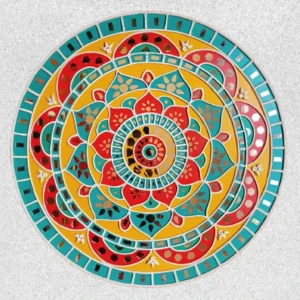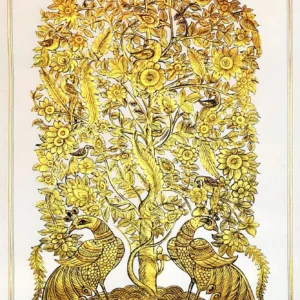-
By: TeamMeeta
-
August 29, 2024
Exploring the Timeless Beauty of Traditional Indian Art Forms
India’s rich and diverse cultural heritage is reflected vividly in its traditional art forms. From the intricate brushstrokes of Tanjore paintings to the vibrant storytelling in Madhubani art, every piece is a testament to the country’s deep-rooted artistic traditions. In this post, we explore some of the most renowned traditional Indian art forms, each unique in its style, history, and significance.
1. Tanjore Painting: The Radiance of Southern India
Originating from the town of Thanjavur in Tamil Nadu, Tanjore paintings are renowned for their rich colors, surface richness, and compact composition. Characterized by the use of gold foil, these paintings often depict Hindu gods and goddesses, particularly Lord Krishna, in elaborate forms. The art is known for its three-dimensional effect, achieved by embedding precious stones and pearls in the artwork, making them not only a form of spiritual devotion but also a symbol of prosperity.
2. Pichwai Art: Devotion in Every Detail
Pichwai art, which originated in Nathdwara, Rajasthan, is an intricate painting style dedicated to the worship of Lord Krishna, specifically his incarnation as Shrinathji. These paintings are characterized by their intricate details, vibrant colors, and elaborate depictions of temple rituals, festivals, and daily life scenes. Often created on cloth, Pichwai paintings are more than just art; they are visual hymns, bringing a sense of devotion and spirituality to the viewer.
3. Madhubani Art: Colors of Mithila
Madhubani painting, or Mithila art, originates from the Mithila region of Bihar and Nepal. Traditionally done by the women of the region, this art form uses natural dyes and pigments to create bold, colorful patterns on paper, cloth, or walls. The themes often revolve around nature, mythology, and Hindu deities, with motifs of fish, peacocks, and the tree of life symbolizing prosperity and fertility. The distinctive style is marked by its double line borders, vibrant colors, and geometric patterns that create a visual narrative of Indian rural life and folklore.
4. Pattachitra: Scrolls of Storytelling
Pattachitra, meaning “cloth painting,” is a traditional art form from Odisha and West Bengal. These paintings are known for their intricate details, mythological narratives, and elaborate borders. Originally, Pattachitra artists, or “Chitrakars,” would paint scenes from Hindu mythology on long cloth scrolls that were then unrolled to narrate stories to village audiences. The vibrant colors and meticulous brushwork continue to captivate art lovers, keeping alive a tradition that dates back to the 5th century BC.
5. Lippan Art: Mirror Work from the Rann of Kutch
Lippan art, also known as mud and mirror work, hails from the Kutch region of Gujarat. Traditionally crafted by the Rabari community, this art involves creating intricate patterns on walls using clay and small mirrors. The reflective mirrors against the earthy tones of the clay create a stunning interplay of light and texture. Today, Lippan art has evolved into modern wall decor, bringing the rustic charm and reflective beauty of Kutch into contemporary homes.
6. Kerala Mural: Wall Canvases of the Gods
Kerala murals are traditional frescoes found on the walls of temples and palaces in Kerala. These murals are known for their natural pigments and striking use of colors like red, green, and yellow ochre. Typically depicting scenes from Hindu mythology, these paintings are characterized by their unique representation of human figures, intricate ornamentation, and the expressive portrayal of gods, goddesses, and celestial beings.
7. Warli Art: Simplicity with Profound Depth
Warli art, from the indigenous Warli tribe of Maharashtra, uses simple white paint made from rice paste on a mud background to depict scenes of daily life, farming, hunting, and village rituals. Despite its simple style, Warli art holds a profound cultural depth, symbolizing the tribe’s connection with nature and their community life. The use of geometric shapes like circles, triangles, and squares adds a unique and rhythmic pattern to each artwork, making it a celebrated style in modern folk art.
8. The Evolution of Traditional Indian Art in Contemporary Spaces
While these traditional art forms have deep historical and cultural significance, they have also evolved to find their place in modern homes and galleries. Contemporary artists are blending these ancient techniques with modern aesthetics, ensuring these age-old traditions remain relevant in today’s world. From adorning living room walls to inspiring fashion and textile designs, traditional Indian art forms continue to captivate and inspire.
Celebrating a Living Heritage
The timeless beauty of traditional Indian art forms lies not only in their intricate details and vibrant colors but also in their ability to tell stories of devotion, mythology, and daily life. These art forms are more than just decorations; they are living narratives, passed down through generations, preserving India’s rich cultural heritage. As we continue to explore and celebrate these traditions, we ensure that the essence of Indian art remains alive and vibrant, adding beauty, meaning, and depth to our lives and spaces.
By embracing and showcasing these traditional art forms, we keep alive the legacy of countless artisans who, with each stroke and pattern, have painted the history, spirituality, and soul of India.








Leave a comment